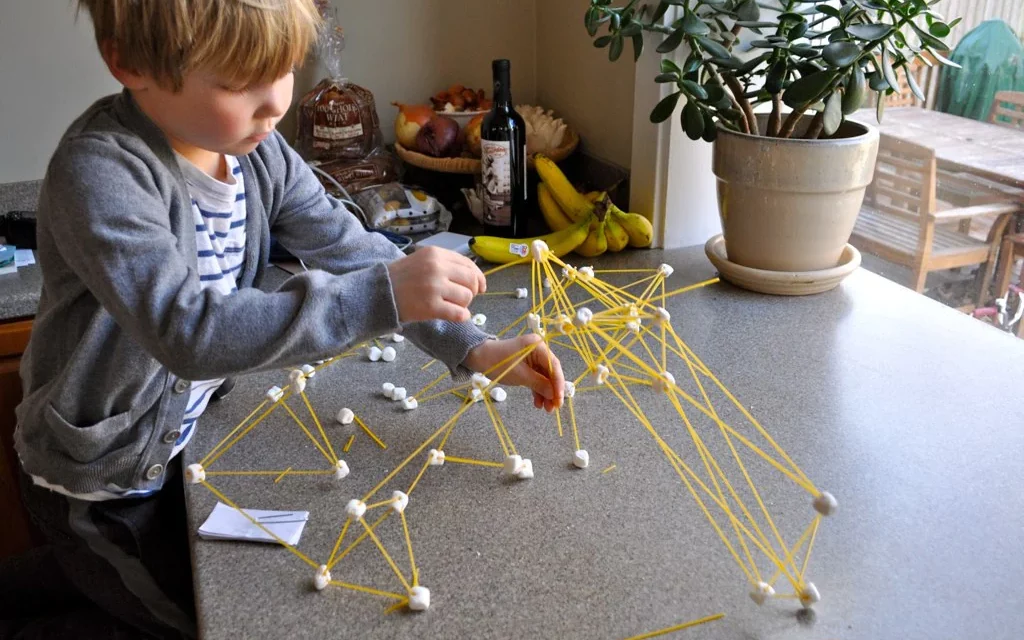Setting up an indoor activity space in the home during winter.
6 Indoor Activities to Keep Children Active This Winter
When the temperatures drop and outdoor play is not an option, ensuring your little one gets enough physical activity every day can be a challenge. It is important for children to get plenty of physical movement daily to be healthy in body and mind. We all know how frustrating it can be as adults to spend days and nights cooped up inside during the winter, and cabin fever has an even more drastic impact on children.
When young children don’t get a chance to move their bodies, they get cranky and often act out. Not to mention they don’t get the physical activity they need to stay healthy. This winter, keep some of these creative ideas in your back pocket for indoor activities that get kids moving:
1. Build a fort: Enlist your child to help you gather all the pillows and blankets he can find from around the house while you set up the fort “walls” with a table and chairs. Get creative and ask him to help you fill in the walls with cushions from the couch, blankets, and other soft items. Between racing around to find and haul all of the materials for the fort and the physical challenge of building it, your little guy will exert plenty of energy and be ready to snuggle up for a story and nap inside his masterpiece.
2. Boogie time: Have a dance party with your child! Find some fun, upbeat music, turn up the volume and move your bodies together. You can play a game of FREEZE with the remote in hand. Tell your child when the music stops, you both stop and freeze; when the music starts again, you move to the beat. Not only will your child (and you) get some healthy body movement, but it’s good practice in following directions AND bonding time.
3. Cotton ball races: Use two cotton balls to do a fun race with your child. In a wide open space, create a finish line several feet away. Get down on your bellies and, without using your hands, blow your cotton balls to the finish line while scooting along the floor. This game helps children realize the power of deep breathing and full exhales while providing healthy movement and some friendly competition.
4. Sock toss: Create a fun game with a laundry basket and a pile of balled-up socks. Place the laundry basket at a challenging but reasonable distance from your child and have her try to toss the socks into the basket. Provide a celebratory round of applause for every “basket” she makes. When she misses, cheer her on with encouraging words like, “Keep trying!” and “You can do it!” This game is a good way to get children to move their bodies and hone hand-eye coordination.
5. Velcro darts: Make your dartboard using a felt-covered board and Velcro tape. Wrap more Velcro around several ping pong balls and have your child try to throw the balls onto the dart board. Much like the sock toss, this is a fun way to get children to move, develop aim and focus skills, and experience your encouragement.
6. Bake a cake: Set up a special baking station with a stool for your child. Let him crack the eggs (always a favorite for children), pour the measured ingredients into the bowl, and stir the batter by hand. Once the cake is baked and cooled, let him spread the icing. This experience teaches children stepstep-by-stepuencing, cause, and effect, and allows them to flex gross and small motor skills.
HOW TO CREATE THE PERFECT KIDS’ GAME ROOM FOR THE WINTER
As the colder months draw in, it’s time to bring the kids indoors to keep them warm and dry during playtime. This change from running around outdoors to being cooped up inside has many implications for your home life. It means making space in your interior design for their games and toys, as well as thinking about what you do to keep them amused and active.
Read on for our guide to creating a kids’ game room. A dedicated, carefully designed space for children will allow you to keep them entertained without causing chaos in the rest of your home.
Introducing the kids’ game room
The kids’ game room, or playroom, is the ideal solution for keeping kids occupied, as well as storing their stuff and teaching them the responsibility of looking after their own space. It allows you to create a place that’s made for play and nothing else, so it’s somewhere children will love to spend time. There’s also the bonus of making it the designated place for toys and all things creative and messy, leaving the rest of the house spotless.
This separate space can be especially handy during the festive season when friends and family come over with their children, as it gives the adults some peace for catching up.
Indoor activities
Keeping children of all ages entertained while they’re indoors can be particularly tricky without resorting to TV and video games. However, some activities can span several age groups easily, with just a few adjustments.
A reading area with a comfortable nook and a range of books for different ages will give children somewhere to settle for some alone time, and maybe even a nap.
Like reading, arts and crafts never go out of style, so stocking your kids’ games room with child-friendly paints, modeling clay and paper can be an easy way to fill a whole day with quiet play. Younger children could turn their hands to simple seasonal decorations like paper chains, while older children might enjoy mastering the art of origami.
For a more hands-on alternative, you could have children bring the outside in during winter by making terrariums. These are currently a huge decorating trend, but can also be educational and offer endless opportunities for personalization.
Storage solutions
A kids’ game room needs to make efficient and effective use of space, giving children maximum room to play. The key to this is storage – getting toys, games, and craft supplies off the floor and packed away when not in use. In this article, Pritish Kumar Halder discusses indoor activity space in the home during the winter season.
You can enlist kids’ help with this as a way of giving them a degree of ownership over the space. Pick up some brightly colored storage boxes and have your children personalize them: by ensuring the storage solutions have an element of fun, you can make a game of tidying up so kids look forward to using them at the end of the day.
A winter playroom can be a chance to engage children’s imaginations and develop some of their other skills too. Thinking about the type of activities they can do in their playroom and how to use the room for effective storage means you can make it a place of learning and convenience.










